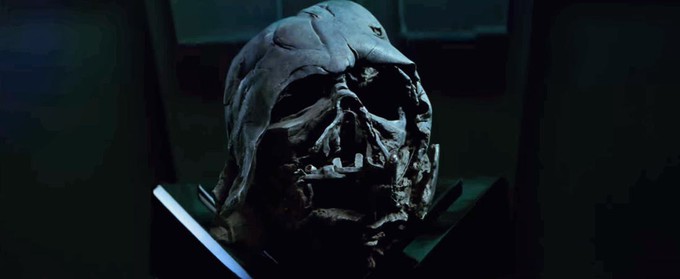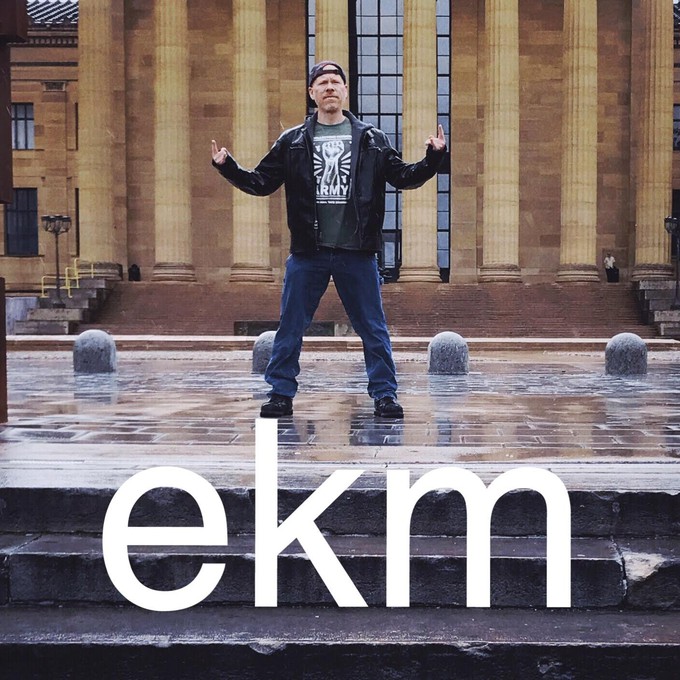ekm’s 31 DAYS OF THE FOURTH: SECOND EPILOGUE – THE ONCE AND FUTURE STAR WARS

Lots of links in this one, which gives you a glance backward at this mammoth series. If you’d like to own a revised and updated version of the entire serial, check out the upcoming book from Roxton Press.
In the week leading up to the release of THE RISE OF SKYWALKER, I revisited the saga for what is a supposed ending that definitely isn’t. This multi-evening experience was composed of my preferred STAR WARS canon: I began with ROGUE ONE, and then blazed through the Original Trilogy, and ended with the two sequels. Neither SOLO nor the Prequel Trilogy were included, as I consider them incongruous, poorly-made, and, at worst, contradictory to the aesthetic of those first three movies as to render them the (theoretically) “lesser” entries by virtue of the lack of comparable bombastic spectacle.
In spite of authoring more than 200 single-spaced pages of content on the Lucas saga for AICN in 2019, I’d not watched STAR WARS, THE EMPIRE STRIKES BACK, or RETURN OF THE JEDI since my previous marathon, one that ended with the opening of THE LAST JEDI. In that time, I’d acquired a 4K television, and the standard for both physical and streaming media had naturally provoked a certain expectation during the interim. That 2017 rewatch had been distressing, given my refusal to watch the SPECIAL EDITIONs of the Original Trilogy, which remain the only way to see the films in a presentation on par with any other mainstream release. As such, I had returned to my laserdisc transfers, which barely held up on a 1080p monitor. Going straight into THE FORCE AWAKENS in glorious hi-def had upset me, all the more for how little it is to expect one’s favorite movies not to look the way any other film would if viewed by squinting through a plastic bottle.
So this time, I finally made the jump to the so-called “Despecialized Edition,” created by a likeminded fundamentalist named Petr "Harmy" Harmáček. I have written at length about my hatred of the SPECIAL EDITIONs, both in terms of what they are and what they represent; I have also made clear my habit of viewing STAR WARS, THE EMPIRE STRIKES BACK, and RETURN OF THE JEDI by way of upscaled laserdisc only. I’ve been collecting bootlegs of the Original Trilogy for nearly twenty years, each version substantially better than its predecessor, and while I’ve been quite aware of the DESPECIALIZED EDITIONs, I’ve very consciously avoided them.
For those unaware of these particular iterations, the short version is this: Harmy and his team of zealots chose to undertake the grueling task of removing all the SPECIAL EDITION changes, starting first with the 2011 blu ray editions of the films, and then splicing, rotoscoping, recoloring, and recutting non-CGI footage from each of the three movies, using whatever the best available sources happened to be. In some cases, these alterations involved lifting specific elements from a shot and blending them into the hi-def versions; in other cases, whole sequences had to be replaced using laserdisc content. Topping out at an industry-laughable 720p, the DESPECIALIZED EDITIONs remain the best and most easily-digestible way to consume the Original Trilogy as it was presented until 1997.
With all that said, I want to make it very clear — both for your benefit, dear Reader, and for Harmy, should he stumble across this article — that I have nothing but the highest respect for the “Despecialized” team and the hundreds of hours of unpaid work between them. I consider these individuals first responders, in terms of preserving one of our greatest Pop Culture works, and with no renumeration to show for the Herculean undertaking. Nonetheless, I found myself increasingly ill at ease while watching them, having first reveled at the sight of hi-definintion STAR WARS,* and then becoming increasingly uncomfortable beginning with THE EMPIRE STRIKES BACK. By the end of RETURN OF THE JEDI, I was deeply depressed.
The reason why is obvious, but if it isn’t, I’ll clarify. The DESPECIALIZED EDITION transforms the STAR WARS Trilogy into competently-shot films with lousy special effects, which is the opposite of what made these movies (in large part) so iconic. In his attempt to update what he considered dated practical work, George Lucas has stamped digital fingerprints on nearly every optical, right down to the matte paintings. This necessitates Harmy’s use of inferior sources than the 2011 blu rays that form the skeleton of each film. Thus, whenever we cut to a flying speeder or Ralph McQuarrie landscape, the resulting drop in visual quality renders the work ugly when paired against the crisp footage of actors engaging with said effects. If STAR WARS signaled anything beyond the Age of the Blockbuster Franchise, it’s undoubtedly a new standard for creating the impossible. Watching the DESPECIALIZED EDITION turns things the other direction, as these triumphs of design, motion control camerawork, and optical effects, look frankly terrible because they’re the only elements to look that way. Plus, the 720p presentation meant that these were already outdated. By the end of that screening, I realized I had no choice but to return to the laserdiscs, where ugly aliasing, dirt, scratches, and molasses-level clarity was at least consistent throughout, and tricked you into compensating.** In other words, everything I was afraid of about THE DESPECIALIZED EDITION had been true.
This brought all my old frustrations back to the surface, as the inevitable realization hit me: the likelihood remains that we will never again see the STAR WARS many of us grew up on. The level of compromise necessary to enjoy the films exists whether one chooses to watch the DESPECIALIZED EDITION, laserdisc, VHS, or the digitally-molested versions. Anyone selecting STAR WARS from the Disney+ menu is going to end up watching beautiful, 4K transfers of the Maclunkey Editions, which are likewise due for release on physical media this spring. All options exist only by way of concession. There is no other work of art for which this sort of draconian stranglehold exists.
I circled back around to the Prequels out of morbid curiosity, as I was particularly interested in the 4K transfer of THE PHANTOM MENACE, a film I consider the best of the three (weak praise, indeed), in part due to its combination of 70mm film, and the groundbreaking digital work employed. It was horrifying, to put it mildly. Suddenly, every digital element now leaps from the screen like a rapist from the bushes, underlining that everything down to doors were artificial. I had just taken my son to see FROZEN 2, and now, for the first time, all the seams were showing on THE PHANTOM MENACE, and it looked every bit as much a cartoon as Disney’s non-photorealistic efforts. This is hardly news, but it didn’t scream in agony the way it does now.
My day-long binge-watch of the Prequels, along with the new emphasis on artifice, led me to a realization that should be equally obvious, and nonetheless required this experience to fully click. STAR WARS was traditionally a franchise that employed substantial trickery to pull off its set pieces, and yet it was tactile. Models, miniatures, sets. There was weight and realism. These were actual things, in front of a camera lens. STAR WARS was many things, but it was never animation. STAR WARS was never a cartoon. Yet these were the methods employed to create the Prequels, and now more than ever, it shows. There are many reasons why those films don’t feel of a piece, ranging from storytelling to performance, but the overall presentation is the nail in the ugly, shot-on-video coffin.
Meanwhile, the rumored spin-off shows, film trilogies, and cash-ins continue to gain momentum. I enjoyed THE MANDALORIAN as much as the next person, but given the choice of cheapening STAR WARS with a deluge of content, and retaining what made it so special — one film every three years — I’d happily throw that show on the funeral pyre. STAR WARS is just another thing now. It’s another movie series, and another TV series. Even THE RISE OF SKYWALKER, which was so heavily promoted as “the end” of Luke’s story, is filled with setups for future spin-offs. I love Marvel; I just don’t want that particular chocolate in my peanut butter.
STAR WARS is bigger than me, and it’s bigger than you. It’s a touchstone of Pop Culture. Once upon a time, it was something to discuss and debate in comic shops and other Geek meccas; now it provokes anger and social and political ire. Loyalists want the films they grew up on; nu-Loyalists want whatever they’re given. There are heroes on both sides. Evil is everywhere.
I love STAR WARS. And now I think I need a break from STAR WARS. It needs to fade, and become the stuff of legend once again, before triumphantly re-emerging from the shadows. Until that time, those of us who were there in the beginning have no choice but to watch the twin suns set, and unlearn what we have learned.
___________________
*Since seeing THE SPECIAL EDITIONS theatrically in 1997 (and then once on VHS), I have watched the Lucasfilm-approved cuts only twice more: once when the Trilogy was released on DVD in 2004 (with further changes), and then again on blu ray in 2011 (with further, further changes). I’ve certainly referenced clips and scenes in my obsession over this lumbering, evolving monstrosity that is STAR WARS, but with those few exceptions, I’ve not seen any degree of image detail in these films for decades.
**I fully anticipate the counterargument that FX work from 1977, 1980, and 1983 might not hold up to 4K restoration, but this can be said of any movie from any era. The problem here is that it’s been erased outright, or altered in ways that don’t reflect the work of the artists who created it. I would rather have dated work than replacement effects, particularly ones that are actually more dated due to the primitive nature of 1997 CGI — and laserdisc is simply not an acceptable alternative, but it’s all we’ve got.

Erik Kristopher Myers (aka ekm)
Pretentious Filmmaker
@ekmyers
https://www.facebook.com/ekmyers
